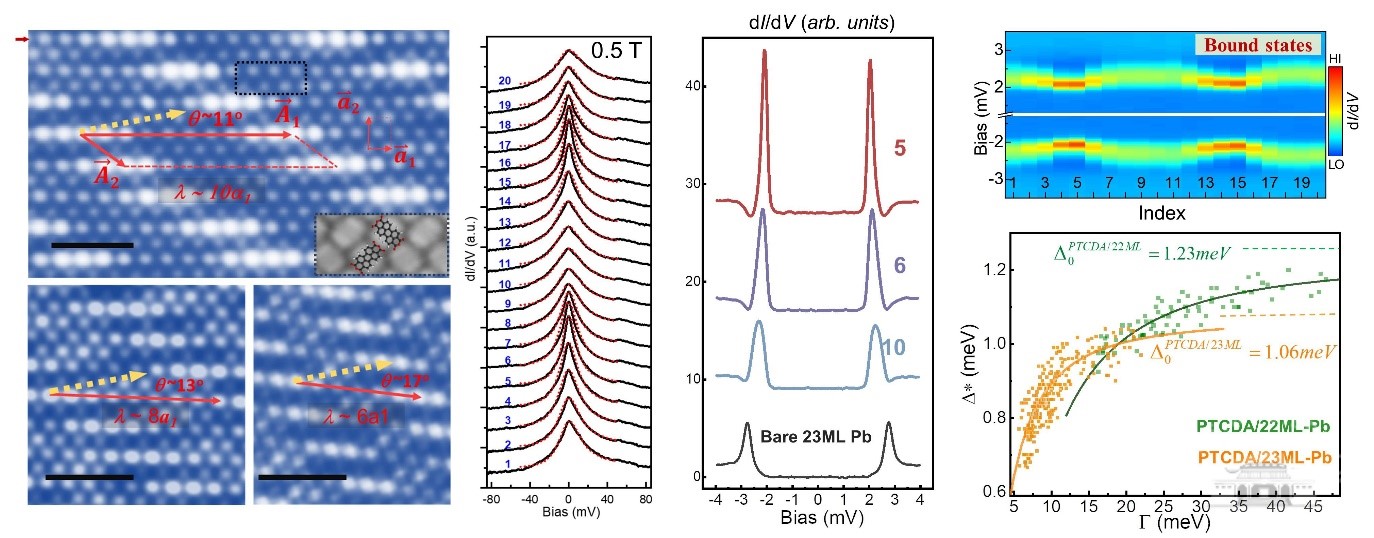The international academic journal Physical Review Letters has published online important advances made by Zhang Chendong’s research group in the research of magnetic superconducting heterogeneous structures of organic molecules.
The paper is entitled PTCDA Molecular Monolayer on Pb Thin Films: An Unusual π-Electron Kondo System and Its Interplay with a Quantum-Confined Superconductor. Doctor Lu Shuangzan from the School of Physical Science and Technology of Wuhan University is the first author, and Professor Zhang Chendong from Wuhan University and Professor Chin-Kang Shih from the University of Texas (Austin Campus) are the corresponding authors. with the School of Physical Science and Technology of Wuhan University acting as the first corresponding affiliation.

The PTCDA single molecule layer on the lead film forms Moore superlattice at different corners; the binding state in the Kondo resonance peak and the superconducting energy gap shows Moore modulation characteristics; the significant regulation of effective superconducting sequence parameters after the hybridisation of the PTCDA single molecule layer and thickness of 22/23 ML lead superconducting film.
Near-neighbour hybridisation between the two mutually exclusive physical properties of magnetism and superconductivity reveals a variety of novel quantum phenomena. So far, in the experimentally explored superconducting-magnetic system, the magnetism mainly comes from unpaired d/f electrons in transition metal atoms. Compared with them, π-electrons have larger spin correlation length and ultra-fine spin-orbit coupling characteristics, showing completely different behaviours. As a result, the magnetism of π-electron construction (under harsh conditions, only few examples have been reported so far) has attracted great interest, and the experimental π-electron magnetism has never been explored in combination with superconductors. In addition, for π-electron magnetic systems, there is a lack of effective methods to modulate the magnetic dipole moment concentration and magnetic interaction intensity, which greatly limits people's in-depth exploration of the novelty of π-electron magnetic systems.
During the process, the researchers constructed a new magnetic-superconducting hybridisation system by depositing an organic molecule PTCDA monolayer on an ultra-thin superconducting lead film. Although neither material is magnetic, the hybrid PTCDA molecular layer has a net spin magnetic moment in a single-occupied molecular orbit due to interfacial charge transfer. Due to the non-localisation of π-electron magnetic moment in PTCDA molecular membranes, the Kondo resonance state near the Fermi energy level and the bound state in the superconducting energy gap both show that the electron behaviour based on the f/d-electron magnetic moment system, showing the two-dimensional correlation electron spectroscopy characteristics. What's more interesting is that the PTCDA single molecular layer forms a Moore superlattice with adjustable rotation angle on the lead film, which provides a rare modulation opportunity to explore the interaction between Kondo shielding and superconductivity.
In addition, the research finds that the quantum-limiting effect of lead films of different atomic thicknesses shows unexpected modulation effects on interfacial charge transfer, dipole moment concentration and superconducting sequence parameters.
The research integrates elements such as π-electron magnetic moment, low-dimensional superconductor, Kondo shielding, corner Moore modulation and quantum domain-limiting effect into a simple system for the first time, providing a flexible regulatory quantum material platform. It is supported by the National Key Research and Development Plan, the National Natural Science Foundation of China, and the Strategic Pilot Science and Technology Special Project of the Chinese Academy of Sciences.
Passage link:
https://link.aps.org/doi/10.1103/PhysRevLett.127.186805
rewritten by:Xie Anqing
edited by: Wang Xuanqi, Zhang Ruoxi, Sylvia and Hu Sijia